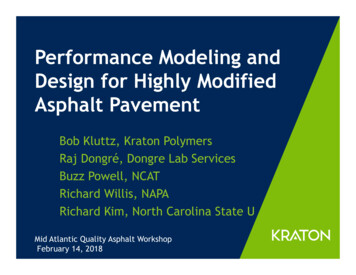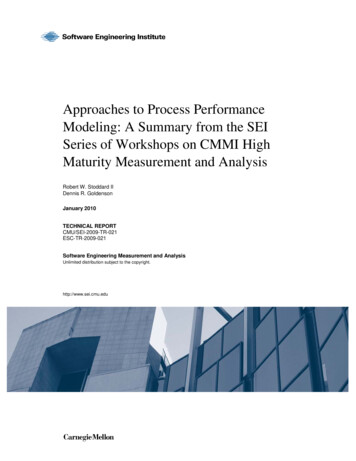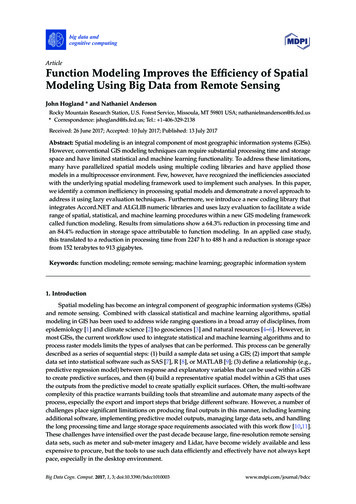
Transcription
Performance Modeling andDesign for Highly ModifiedAsphalt PavementBob Kluttz, Kraton PolymersRaj Dongré, Dongre Lab ServicesBuzz Powell, NCATRichard Willis, NAPARichard Kim, North Carolina State UMid Atlantic Quality Asphalt WorkshopFebruary 14, 2018
Outline What is highly modified asphalt? NCAT test track section performance AASHTOWareTM Pavement ME Design modeling FLEXPaveTM software FLEXPave modeling Conclusions and where we go from here
What Is Highly Modified Asphalt? Highly Modified Asphalt isexactly what it says, asphaltwith more than double thenormal amount of SBS polymer. This gives a much denserpolymer network with up to 10Xrutting and fatigue crackingresistance.Over 3,000,000 tons in over70 projects around the worldhave demonstrated superiorperformance at reducedthickness.3
PMA Producer’s Perspective Polymer Handling Blending Storage & Pumping Transport For all, no problem—handles like normal PMA.4
HiMA Specifications North ew HampshireOhioOregonNew York CityUtahVermontWashingtonAASHTO M 320AASHTO T301AASHTO M 332 AASHTO T 350PGPG specification Elastic Recovery specification MSCR RecoveryPG 76E-2295%PG 64E-4090%PG 76E-2890%PG 76E-2290%PG 76E-2290%PG 76E-2895%PG 76E-2890%PG 70E-3490%PG 76E-2890%PG 82-2290%PG 76-3490%PG 76-3490%PG 76-3490%PG 88-22M90%PG 76-2890%PG 76-3490%PG 76-3490%PG 76-3490%PG 76-3490%5
National Center for Asphalt Technology Test Track 5 trucks, 16 h/day, 5days/week Axle load: 18 kip Speed: 45 mph
National Center for Asphalt Technology Test Track Track cycle of 10 million ESALs simulates the design lifetime ofdamage in 2 years ESAL Equivalent Single Axle Load 1 pass of 18 kip axle Highly Modified Asphalt (HiMA) project started in 2009 cycle Part of Performance Group study—6 sections including control Continued in 2012 cycle Total 20 million ESALs
Control (S9) and HiMA (N7) Section Designs7 in5¾ in
Crack Maps at 17 Million ESALs
Rutting over 20 Million ESALsESALsS9N7
N7 Crack Map at 20 Million ESALsS9 resurfaced at17 million ESALsN7 cracking is superficial top-down
AASHTOWareTM Pavement ME Design Traditional layered elastic model Comprehensive input data Fatigue cracking model Nf-HMA kf1(C)(CH)bf1(εt)kf2bf2(EHMA)kf3bf3 Permanent deformation model Dp(HMA) εp(HMA)hHMA br1kzεr(HMA)10kr1ηkr2br2Tkr3br3
Fatigue Global Calibration Parameters
Fatigue Calibration Factors for Section N7kf1kf2kf3MEPDG Standard Values7.566E-33.94921.2810S9 Calculated Values1.4964E-23.94921.2810N7 Calculated E-32.99940.0630RatiosN7 Adjusted Values
Rutting Global Calibration Parameters
Rutting Calibration Factors for Section N7kr1kr2kr3MEPDG Standard Values-3.35410.47191.5606S9 Calculated 7 Adjusted Values-2.69850.22611.5606
S9Predicted CrackingPredicted AC Bottom-Up CrackingPredicted AC Bottom-Up CrackingSpecified Reliability2018161412108642050% ReliabilityBottom-Up Cracking (%)Bottom-Up Cracking (%)50% ReliabilityMeasurement DatesN7Specified Reliability20181614121086420Measurement Dates
S9Predicted RuttingN7
Predicted damage summaryPavement DistressS9N7Total Permanent Deformation, mm10.28.4AC Permanent Deformation, mm6.41.5Bottom-Up Cracking, % Area181.5Pavement DistressS9N7Total Permanent Deformation, mm6.01.6AC Permanent Deformation, mm6.01.6Bottom-Up Cracking, % Area100Measured damage summary
FlexPAVETM 1.0 Three dimensional layered viscoelastic analysis for moving loads and thermal stressesFatigue performance analysis based on ViscoelasticContinuum Damage (VECD) ModelRutting performance analysis based on the shiftmodelSupport for multiple axle and multiple wheel loadingIntegrated with EICM software to capturetemperature variation for thermal stress analysisand material propertiesIntegrated GUI that includes pre and post processors
General Information
Damage Contour
FlexPAVETM SimulationNCAT Test Track 2009 Performance GroupOGFCFoamEvothermControlRAP WMAHigh RAP
FlexPAVETM SimulationNCAT Test Track 2009 Section N71.09/1/099/1/109/1/119/1/139/1/140.09/1/127% Damage (Bottom-up)65432100.0E 001.0E 07ESALs2.0E 07
FlexPAVETM SimulationNCAT Test Track 2009 Section N7 Expanded .09% Damage (Top-down)0.080.070.060.050.040.030.020.0100.0E 001.0E 07ESALs2.0E 07
% Cracking MeasuredNCAT Test Track Prediction60O5040FW30AWC2010RWR057911% Damage Predicted1315
Conclusions NCAT section N7 developed fine surface cracking late inits life, but forensic analysis showed that the crackingwas minor top down cracking not impacting the structuralintegrity of the pavement. Highly modified asphalt may be useful in perpetualpavement design. Demonstrated performance up to 20 million ESALs showsthat the thickness of pavement structures may bereduced while retaining or even improving long termperformance.
Conclusions AASHTO M332 specifications (plus elastic recovery) havebeen effective to specify HiMA binders for commercialapplications. Standardized test methods in increasingly common useare adequate to characterize HiMA mixtures for thepurpose of pavement design. The current Pavement ME Design protocol is suited todesigning perpetual pavements with highly modifiedasphalts. Relative global calibration factor adjustmentwith Level 1 design gives performance predictions thatagree well with actual field performance relative toknown structures.
Conclusions Both AASHTOWare Pavement ME DesignTM andFlexPAVETM are effective design tools. ME Design currently lacks a validated model fortop-down cracking. FlexPAVE currently lacks a built-in aging model andso required aged material properties. We will be doing follow up modeling with both tocompare!29
HiMA Market Applications –Where Does it Add Value? Structural Applications With a sound base, thinner pavements with lower upfront cost Demonstrated in many field applications & Ohio University APLF With weak base, much longer lifetime can be achievedThin Overlays Superior resistance to reflective cracking BUT requires finer, richermix.Preservation Surfacing such as micro surfacingOpen Grade Mixes for Reduced RavelingSAMI LayersHigh Stress Applications – ramps, intersectionsAASHTOWare Pavement ME Design works for HiMA designs30
In General Terms, What Does HiMA Do toMixture and Performance Characteristics? Modulus Cracking RuttingResistanceResistance CrackingVersus Rutting StructuralIntegrity31
Dynamic Modulus Testing Results –9.5 mm NMAS Mixtures32
Four Point Bending Beam Fatigue Resultsload cycles [Nf]1.E 081.E 07mix 40mix 41mix 42mix 41mix 481.E 06(2004)(2004)(2004)(2008)(2008)1.E 051.E 04101001000microstrainFull sinusoidal loading. Cited strains are ½ amplitude33
TX DOT Overlay Specifications – Coarse Dense Mix12.5 mm max HamburgTX DOT specification34
TX DOT Overlay Specifications – Fine Rich Mix12.5 mm max Hamburg 750 min OverlayTX DOT specification35
Thickness Reduction Capability207mm (1)StdBitumen-60%83 mm(2)HiMA238mm (1)StdBitumen146mm (2)HiMA-39%-34%270mm (1)StdBitumen179mm (2)HiMA294Mm (1)StdBitumen-22%228mm e20MPaSubgrade20MPaGood quality sub base (1) Thickness determined by asphalt strain criterion(2) Thickness determined by sub grade strain criterionPoor quality sub baseHiMA Highly Modified Asphalt36
HiMA Mixture and Pavement Design Concepts So how should these observations apply todesign principles? Structural Pavement – Strong Base Structural Pavement – Weak Base Overlay – Undamaged Pavement Overlay – Damaged Pavement Waterproof Bridge Deck SAMI37
Structural Pavement – Strong BaseLowest strain. Best Case! Key distress—bottom up fatiguecracking Solution—standard mix design,perhaps slightly richer, 0.2-0.3%. Thinner pavement design for lowerup front cost and life cycle cost for aperpetual pavement. load cycles [Nf]1.E 081.E 07mix 40 (2004)mix 41 (2004)mix 42 (2004)mix 41 (2008)mix 48 (2008)1.E 061.E 051.E 04101001000microstrain38
Structural Pavement – Weak BaseModerate strain. Key distress—risk of subbase,subgrade damage, bottom upcracking. Solution—rich bottom layer, little orno thickness reduction. Likely more expensive up front cost,but perpetual pavement vs. rehabevery few years. load cycles [Nf]1.E 081.E 07mix 40 (2004)mix 41 (2004)mix 42 (2004)mix 41 (2008)mix 48 (2008)1.E 061.E 051.E 04101001000microstrain39
Overlay – Undamaged PavementLow strain. Key distress—should be able toachieve substantial thicknessreduction, but be aware of potentialfor rutting below surface. Solution—standard mix design,perhaps 0.2-0.3% richer to be on thesafe side. Thinner pavement for lower up frontcost and life cycle cost. load cycles [Nf]1.E 081.E 07mix 40 (2004)mix 41 (2004)mix 42 (2004)mix 41 (2008)mix 48 (2008)1.E 061.E 051.E 04101001000microstrain40
Overlay – Damaged Pavement Very high localized strain.Key distress—reflective cracking.Solution—take advantage of ruttingresistance with a finer, richer mixthan standard, e.g., New JerseyHPTO mixload cycles [Nf]1.E 081.E 07mix 40 (2004)mix 41 (2004)mix 42 (2004)mix 41 (2008)mix 48 (2008)1.E 061.E 051.E 04101001000microstrainMix expensive up front mix, butmuch better life cycle cost analysis.41
Waterproof Bridge Deck Mix High strain. “Zero” voids.Key distress—fatigue cracking, waterpermeationSolution—very rich fine mix with 2%voids.Lower cost & far better workability thanalternatives.load cycles [Nf]1.E 081.E 07mix 40 (2004)mix 41 (2004)mix 42 (2004)mix 41 (2008)mix 48 (2008)1.E 061.E 051.E 04101001000microstrain42
Stress Attenuating Mix Interlayer (SAMI)High strain. Low voids. Key distress—reflective cracking. Solution—very rich fine mix with lowvoids. Lower cost than thick structurallayer. load cycles [Nf]1.E 081.E 07mix 40 (2004)mix 41 (2004)mix 42 (2004)mix 41 (2008)mix 48 (2008)1.E 061.E 051.E 04101001000microstrain43
Legal DisclaimerKraton Corporation and all of its affiliates, including Arizona Chemical, believe the information set forth herein tobe true and accurate, but any recommendations, presentations, statements or suggestions that may be made arewithout any warranty or guarantee whatsoever, and shall establish no legal duty on the part of any Kratonaffiliated entity. The legal responsibilities of any Kraton affiliate with respect to the products describedherein are limited to those set forth in Kraton’s Conditions of Sale or any effective sales contract. NOTE TOUSER: by ordering/receiving Kraton product you accept the Kraton Conditions of Sale applicable in theregion. All other terms are rejected. Kraton does not warrant that the products described herein aresuitable for any particular uses, including, without limitation, cosmetics and/or medical uses. Persons usingthe products must rely on their own independent technical and legal judgment, and must conduct their ownstudies, registrations, and other related activities, to establish the safety and efficacy of their end productsincorporating any Kraton products for any application. Nothing set forth herein shall be construed as arecommendation to use any Kraton product in any specific application or in conflict with any existing patentrights. Kraton reserves the right to withdraw any product from commercial availability and to make any changesto any existing commercial or developmental product. Kraton expressly disclaims, on behalf of all Kratonaffiliates, any and all liability for any damages or injuries arising out of any activities relating to the use ofany information set forth in this publication, or the use of any Kraton products.*KRATON and the Kraton logo are either trademarks or registered trademarks of Kraton Corporation, or itssubsidiaries or affiliates, in one or more, but not all countries. 2018Kraton Corporation44
NCAT section N7 developed fine surface cracking late in its life, but forensic analysis showed that the cracking was minor top down cracking not impacting the structural integrity of the pavement. Highly modified asphalt may be useful in perpetual pavement design. Demonstrated performance up to 20 million ESALs shows











